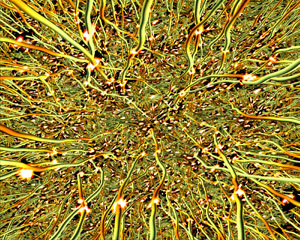






 |
 |

Axon Forest
Caption:
This image shows a group of pyramidal cell axons as they simultaneously convey a burst of spikes from one cortical layer to another. The bits of "fire" depicted on the axons represent "spikes" of electrical activity that travel down the axon and carry information within the brain.
Despite the large number of cells pictured in this visualization, this would only be a small percentage of the total number of cells found in an actual cortex. The space between the axons would be filled with other axons, other type of neurons, and other cell types such as glial cells. [See related images: Pyramidal Cell in Cortical Layers, Cells in the Lateral Geniculate Nucleus, and Pyramidal Cells in the Visual Cortex.]
Important: Use of this image is restricted. Please see “Restrictions” (below) for complete information.
More about this Image
This still image was derived from animations developed by Greg Hood, John Burkardt, and Greg Foss of the Pittsburgh Supercomputing Center. The work contributed to the planetarium show "Gray Matters: The Brain Movie," which debuted in 1999 at the Carnegie Science Center in Pittsburgh. With the brain's neural structure projected on the 3D space of the planetarium dome, "Gray Matters" offers an interactive, multi-media lesson in the science of the brain for children and adults.
"Gray Matters" was a collaboration among the Studio for Creative Inquiry at Carnegie Mellon University, the Center for the Neural Basis of Cognition, and the Pittsburgh Supercomputing Center (PSC). The work was supported in part by National Science Foundation (NSF) grant 97-05491.
In 1987, the PSC biomedical program became the first extramural biomedical supercomputing program in the country, funded by the National Institutes of Health (NIH). Since then, with support from the NIH National Center for Research Resources, PSC has fostered exchange between PSC expertise in computational science and experts in biology and medicine to solve important problems in the life sciences.
Through the NSF, PSC provides access to LeMieux, a 3,000 processor terascale system capable of six trillion computations per second. As of March 2003, with support from NIH and NSF, PSC has also installed two 16-processor HP GS-1280 based systems. These two shared memory systems, with very high memory bandwidth -- named “Jonas” and “Rachel” for famous Pittsburgh scientists Jonas Salk and Rachel Carson -- will be upgraded to larger systems.
In addition to training and access to computational resources, the biomedical group carries out research in structural biology, protein and nucleic-acid sequence analysis, computational neuroscience, and microphysiology. In the latter fields, PSC staff work in developing and conducting research with widely used applications software, including MCell, NEOSIM, and PGenesis.

(Preview Only)

|
| Credit: |
Image courtesy of Greg Hood, John Burkardt, Greg Foss; Pittsburgh Supercomputing Center |
| Year of Image: |
1999 |
|
Categories:
COMPUTERS / Supercomputing
NEUROSCIENCE
Formats Available:
TIFF Format - 5.86M - 1280 x 1600 pixel image - 300 DPI
Restrictions:
Important: Permission is granted to use this image for personal, educational, or nonprofit/non-commercial purposes only. Permission to use this image in a manner not stated here must be obtained from the Pittsburgh Supercomputing Center via e-mail at ghood@psc.edu or foss@psc.edu.
|